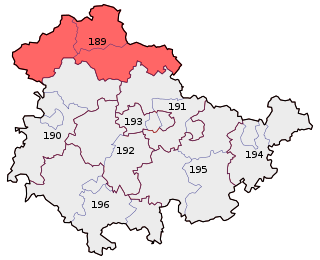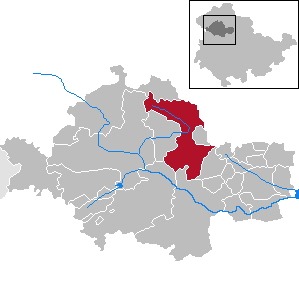Sömmerda is a Kreis (district) in the north of Thuringia, Germany. Neighboring districts are the districts Kyffhäuserkreis, the Burgenlandkreis in Saxony-Anhalt, the district Weimarer Land and the district-free city Erfurt, and the districts Gotha and Unstrut-Hainich-Kreis.
Wartburgkreis is a Kreis (district) in the west of Thuringia, Germany. Neighboring districts are the districts Unstrut-Hainich-Kreis, Gotha, Schmalkalden-Meiningen, and the districts Fulda, Hersfeld-Rotenburg and Werra-Meißner-Kreis in Hesse.

Bad Langensalza is a spa town of 17,500 inhabitants in the Unstrut-Hainich district, Thuringia, central Germany.
Blankenburg may refer to:

Unstruttal is a municipality in the Unstrut-Hainich-Kreis district of Thuringia, Germany.

Großengottern is a village and a former municipality in the Unstrut-Hainich-Kreis district of Thuringia, Germany. Since 1 January 2019, it is part of the municipality of Unstrut-Hainich.
Altengottern is a village and a former municipality in the Unstrut-Hainich-Kreis district of Thuringia, Germany. Since 1 January 2019, it is part of the municipality Unstrut-Hainich.
Mülverstedt is a village and a former municipality in the Unstrut-Hainich-Kreis district of Thuringia, Germany. Since 1 January 2019, it is part of the municipality Unstrut-Hainich.

Weinbergen is a former municipality in the Unstrut-Hainich-Kreis district of Thuringia, Germany. It was created on 30 June 1994 in the course of a territorial reform by the merger of the municipalities of Bollstedt, Grabe, Höngeda and Seebach. On 1 January 2019, Weinbergen was dissolved, and the four villages which it consisted of were incorporated into the territory of the town of Mühlhausen. The Seebach State Bird Protection Station, located in the former municipality, is known beyond the region.

Weberstedt is a village and a former municipality in the Unstrut-Hainich-Kreis district of Thuringia, Germany. Since 1 January 2019, it is part of the municipality Unstrut-Hainich.
Heroldishausen is a village and a former municipality in the Unstrut-Hainich-Kreis district of Thuringia, Germany. Since 1 January 2019, it is part of the municipality Unstrut-Hainich.

Haussömmern is a municipality in the Unstrut-Hainich-Kreis district of Thuringia, Germany.
Unstrut-Hainich is a former Verwaltungsgemeinschaft in the district of Unstrut-Hainich-Kreis in Thuringia, Germany. The seat of the Verwaltungsgemeinschaft was in Großengottern. It was disbanded in January 2019.

Unstrut-Hainich is a municipality in the district Unstrut-Hainich-Kreis, in Thuringia, Germany. It was created with effect from 1 January 2019 by the merger of the former municipalities of Altengottern, Flarchheim, Großengottern, Heroldishausen, Mülverstedt and Weberstedt. The name refers to the river Unstrut and the hill chain Hainich.

Südeichsfeld is a municipality in the Unstrut-Hainich-Kreis district, Thuringia, Germany. It was formed by the merger of the previously independent municipalities Heyerode, Katharinenberg, Hildebrandshausen and Lengenfeld unterm Stein, on 1 December 2011.

Eichsfeld – Nordhausen – Kyffhäuserkreis is an electoral constituency represented in the Bundestag. It elects one member via first-past-the-post voting. Under the current constituency numbering system, it is designated as constituency 189. It is located in northern Thuringia, comprising the districts of Nordhausen, Eichsfeld, and Kyffhäuserkreis.

Nottertal-Heilinger Höhen is a town in the Unstrut-Hainich-Kreis district, in Thuringia, Germany. It was created with effect from 31 December 2019 by the merger of the former municipalities of Schlotheim, Bothenheilingen, Issersheilingen, Kleinwelsbach, Neunheilingen and Obermehler. It takes its name from the river Notter, that flows through the municipality, and the Heilingen hills.
Unstrut-Hainich-Kreis I is an electoral constituency represented in the Landtag of Thuringia. It elects one member via first-past-the-post voting. Under the current constituency numbering system, it is designated as constituency 8. It covers the northwestern part of Unstrut-Hainich-Kreis.
Unstrut-Hainich-Kreis II is an electoral constituency represented in the Landtag of Thuringia. It elects one member via first-past-the-post voting. Under the current constituency numbering system, it is designated as constituency 9. It covers the central, southern, and eastern part of Unstrut-Hainich-Kreis.

Eisenach – Wartburgkreis – Unstrut-Hainich-Kreis is an electoral constituency represented in the Bundestag. It elects one member via first-past-the-post voting. Under the current constituency numbering system, it is designated as constituency 190. It is located in western Thuringia, comprising the city of Eisenach and the districts of Wartburgkreis and Unstrut-Hainich-Kreis.














